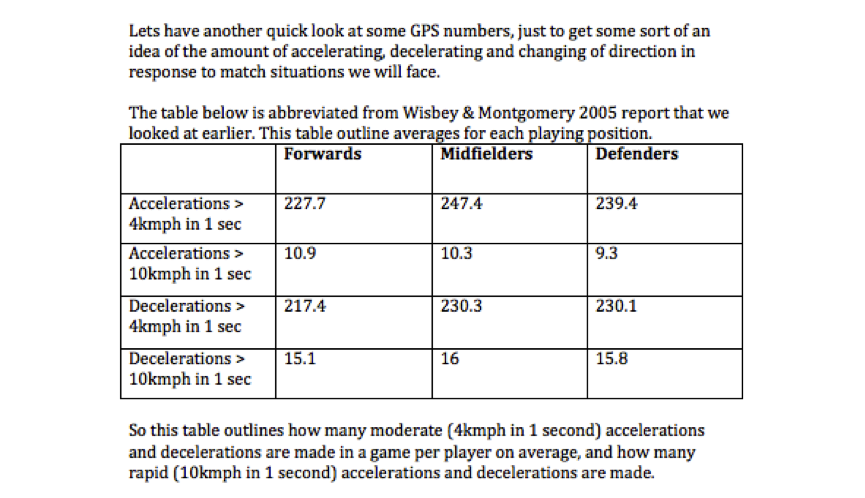Agility & Footy
As we covered in a previous article, as well as in more detail in the books, straight-line speed will certainly be of some benefit to you in a game of footy – getting from point A to point B quicker than your opponent of course will be an advantage. However, not only will you rarely encounter periods where you will be running flat out for more than 3-4 seconds, but the fact is that a game of footy isn’t always played in a straight line – in fact it rarely is. By played in a straight line, I mean running just straight out in front as fast as you can – as if in a 100 meter race. In a game, even in sprints where you may start running straight for 20 or 30 meters, the position of the play or where you need to move will adjust slightly, and so you will no longer simply be sprinting straight ahead.
Similarly, you will be repeatedly required throughout a game to accelerate, decelerate and change directions, shuffle sideways, turn around and sprint again, then decelerate and change directions. These sorts of movements will occur over and over in any infinite number of potential combinations throughout a game. This ability to accelerate, decelerate and change directions efficiently, and maintain control of your movement – are a classic expression of agility. The screenshot below was taken from Agility, Speed & conditioning for Aussie Rules Footy, and includes an abbreviated table from a GPS analysis that we used to highlight the running demands in a game.
Without going into too much detail here, what the table highlights is that there are a lot of decelerations and accelerations. Of course this doesn’t paint the entire picture of agility – you would need maps that chart the direction that the players are going, and specific speeds and the like, however you would know from both playing and watching the type of patterns and changes in direction that occur. This table merely illustrates the number of these movements.
This ability to accelerate, decelerate and change directions quickly and efficiently is the key skill required in footy – and is often what coaches are really talking about when they talk about ‘speed’ or what commentators and journo’s mean when they describe a player as ‘quick.’ They move so efficiently with their agility, that they appear to move like lightning – yet if you got them to run 100 meters, they may be fairly fast, but they wouldn’t necessarily be the fastest player getting around. But why is that?
As Paul Gamble points out in Strength & Conditioning for Team Sports;
‘Speed and agility are distinct abilities that are relatively independent of each other. Furthermore, correlations between measures of these abilities reportedly decrease markedly when any sport skill component is incorporated in the agility test.’
And as Vern Gambetta points out in Athletic Development;
‘The more complex the agility task, the less the transfer of straight-ahead speed training to agility.’
This may initially sound a little surprising, but when thought about a little more closely, it shouldn’t be, as there is a considerable difference in movement mechanics between straight line running and changing directions, with the direction that force is directed, absorbed and also which muscles are being used as well as what way they are being used and the timing of the movements.

There is very little carryover between running flat out in a straight line like a 100-meter race and the ability to be ‘quick and agile’ and combine quick running with slight sideways movement to evade an opponent.
‘Sprinting technique of team sports players appears to be different to that of track athletes. It is also suggested that the acceleration phase for team sports athletes may be shorter so that they acquire top speed quicker.’
Vern Gambettta
‘Speed for rugby players is different. The time taken to reach top speed, the running posture and the arm actions are all different.’
‘High knee lifting should be avoided in either acceleration or deceleration because it increases the time between foot strikes.’
Paul Pook
This is another very interesting point, and there are numerous sources that make this exact same point. We already know that running in a team sport isn’t like running in a straight-line sprint, but the techniques are also different. And this highlights the folly in coaches who still get track coaches in to coach ‘speed’ into their players, or even the coaches who do it themselves, but get so caught up in teaching them sprinter mechanics, that they are at best making the athlete no better, or at worse make them slower in a footy sense, because the player has become too caught up in focusing on a ‘high knee drive’ and ‘arm follow trough’ like a 100 meter sprinter, that they actually aren’t moving as well anymore.
So with these points in mind, what is an exact definition of agility? In ‘Conditioning for Soccer’, Dr. Raymond Verheijen describes agility as;
‘The ability to adjust a movement to take account of a perceived change in the game situation.’
So referring to this definition taken above, there are 2 components to agility;
- The physical component (adjust movement)
- Perceptual component (perceived change in the game situation)
So there is actually more to agility than simply the various forms of accelerating, decelerating and changing directions – there is also a perceptual component. We will discuss this in part 2 of this discussion.
Strength Coach

